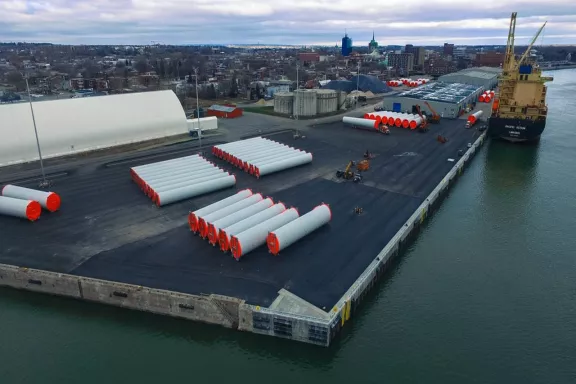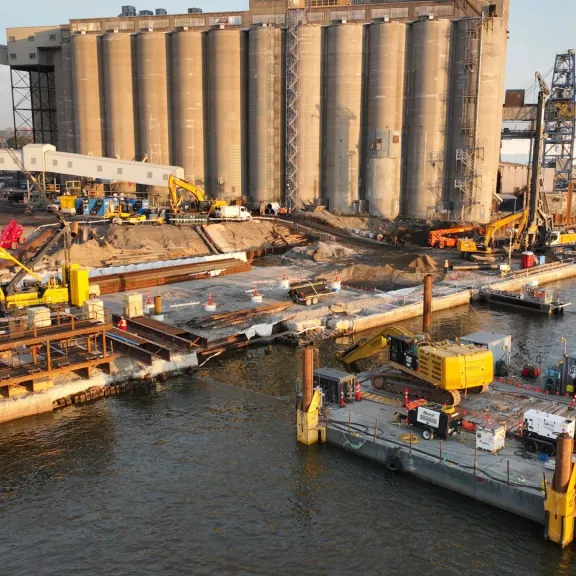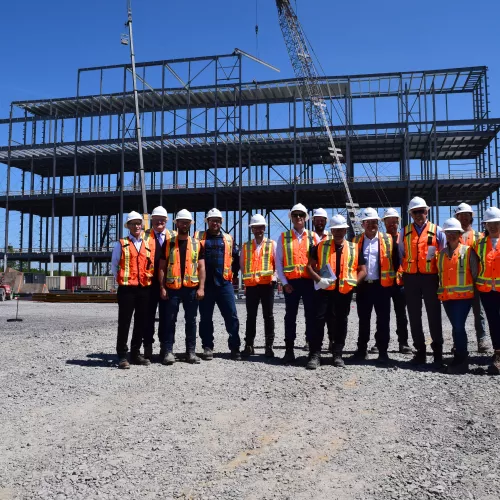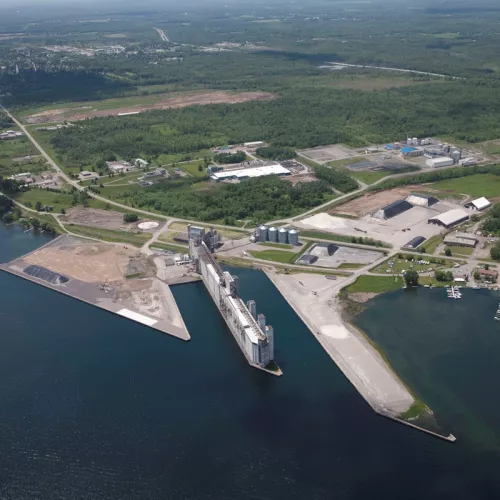
Modernization and Development at the Port of Trois-Rivières
- Client
- Port of Trois-Rivières
- Sector
- Civil & Infrastructures
- Delivery mode
- Lump Sum
- Location
- Trois-Rivières, QC, CA
- Year built
- 2026

Pomerleau has been commissioned for an ambitious project to modernize and secure the port infrastructure, including the demolition and reconstruction of Pier 17, the construction of a brand-new Pier 16, as well as the demolition of the former grain silos on behalf of G3 Canada, as part of the modernization of the grain terminal. This project relies on cutting-edge techniques to improve infrastructure resilience against climatic conditions such as storms and port constraints, with the installation of a 360-meter combined wall, 150-foot-long piles, and the use of recycled materials for backfills and the reconstruction of retaining walls, to optimize load resistance and ensure infrastructure durability.
Deep Foundations and Maritime Works : Ensuring a Solid and Durable Base
Pomerleau guarantees the execution of the work with its own resources, ensuring complete control over operations and strict compliance with port requirements.
The intervention includes the installation of piles and sheet piles, ensuring the stability of the docks against hydraulic constraints and heavy loads. Thanks to cutting-edge techniques and a focus on safety, the completed work guarantees superior quality results, ensuring the durability and resistance of the infrastructures to demanding environmental conditions.
For the reconstruction of Pier 17, the deep foundations and maritime works required the demolition of a 45-meter long and 12-meter-deep underwater anti-scour wall, the replacement of over 37,000 linear feet of piles and sheet piles, and the installation of a double structural membrane of 110,000 square feet, installed underwater. Additionally, nearly 550,000 tons of stones were used to fill the basin, and approximately 20,000 tons of concrete from the old docks were recycled.
Earthworks expertise: ensuring the stability of infrastructure
Earthwork operations are carried out to stabilize the surroundings of the docks and ensure their integration into the urban environment. This includes excavation, leveling, and the installation of backfills, while promoting the reuse of materials from the demolition.
To ensure the safety and longevity of the infrastructures, a new retaining wall is constructed, complemented by the installation of anchor rods to reinforce resistance to loads and marine conditions.
The project of The Port of Trois-Rivières: In numbers
450
3450
90%
50
A Project with Stimulating Challenges, Tackled with Expertise
The improvement of logistics aims to increase the fluidity of road, rail, and maritime traffic, making the supply chain more competitive. These initiatives contribute to the economic and social growth of Trois-Rivières by offering modern and competitive port facilities.
One of the main challenges of the project lies in the coordination of earthwork, which requires smooth and structured management to ensure harmonious progress. The presence of a basin containing fish adds an important environmental dimension, requiring rigorous management of the aquatic ecosystem to maintain its balance. It is crucial to avoid pollution from construction debris or chemicals, as well as excessive turbidity that could reduce water quality and affect marine wildlife. Disturbance of fish habitats and other aquatic organisms must also be minimized to preserve biodiversity.
The noise and vibrations produced by the construction activities pose challenges that need to be addressed. It is essential to implement appropriate measures to minimize these nuisances and ensure that activities are carried out in harmony with their environment.
Demolition is also a major element to consider, especially due to the presence of dust. To limit its dispersion and ensure a healthy work environment, frequent water truck passages are planned. These trucks regularly spray the construction areas to reduce airborne dust. Additionally, managing turbidity in the water is essential to maintain the quality of water resources and avoid altering the surrounding environments.
Silo Demolition Work – A Large-Scale Operation
In parallel with the marine construction, Pomerleau is carrying out the demolition of the former grain silos at the port, an impressive undertaking on behalf of G3 Canada. This operation involves specialized equipment and meticulous planning, including the use of high-reach excavators operating at heights of over 30 meters. The chosen method allows for a progressive and safe demolition while minimizing impacts on surrounding port activities. The project also stands out for its focus on sustainability, with careful recovery and sorting of materials for reuse and recycling. To learn more about this silo demolition operation, read the full article from CBC/Radio-Canada.
Innovative and Sustainable Port Development
Innovation is at the heart of the project, making the Port of Trois-Rivières an urban, sustainable, and innovative port, generating growth. Pomerleau implements innovative solutions to improve the project's sustainability and minimize its environmental impact. The use of 3D and 4D modeling allows for precise and real-time tracking of construction progress, ensuring efficient execution.
In an eco-responsible approach, several measures have been implemented, including the use of dust suppressants, optimization of machinery and vehicle movements, and limiting work in aquatic environments during sensitive periods.


